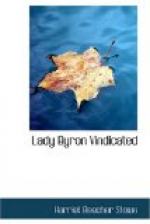We have recently heard it asserted that this last-named piece of poetry was the sudden offspring of a fit of ill-temper, and was never intended to be published at all. There were certainly excellent reasons why his friends should have advised him not to publish it at that time. But that it was read with sympathy by the circle of his intimate friends, and believed by them, is evident from the frequency with which allusions to it occur in his confidential letters to them. {21}
About three months after, under date March 10, 1817, he writes to Moore: ’I suppose now I shall never be able to shake off my sables in public imagination, more particularly since my moral ----- clove down my fame.’ Again to Murray in 1819, three years after, he says: ’I never hear anything of Ada, the little Electra of Mycenae.’
Electra was the daughter of Clytemnestra, in the Greek poem, who lived to condemn her wicked mother, and to call on her brother to avenge the father. There was in this mention of Electra more than meets the ear. Many passages in Lord Byron’s poetry show that he intended to make this daughter a future partisan against her mother, and explain the awful words he is stated in Lady Anne Barnard’s diary to have used when first he looked on his little girl,—’What an instrument of torture I have gained in you!’
In a letter to Lord Blessington, April 6, 1823, he says, speaking of Dr. Parr:— {22a}
’He did me the honour once to be a patron of mine, though a great friend of the other branch of the house of Atreus, and the Greek teacher, I believe, of my moral Clytemnestra. I say moral because it is true, and is so useful to the virtuous, that it enables them to do anything without the aid of an AEgistheus.’
If Lord Byron wrote this poem merely in a momentary fit of spleen, why were there so many persons evidently quite familiar with his allusions to it? and why was it preserved in Murray’s hands? and why published after his death? That Byron was in the habit of reposing documents in the hands of Murray, to be used as occasion offered, is evident from a part of a note written by him to Murray respecting some verses so intrusted: ’Pray let not these versiculi go forth with my name except to the initiated.’ {22b}
Murray, in publishing this attack on his wife after Lord Byron’s death, showed that he believed in it, and, so believing, deemed Lady Byron a woman whose widowed state deserved neither sympathy nor delicacy of treatment. At a time when every sentiment in the heart of the most deeply wronged woman would forbid her appearing to justify herself from such cruel slander of a dead husband, an honest, kind-hearted, worthy Englishman actually thought it right and proper to give these lines to her eyes and the eyes of all the reading world. Nothing can show more plainly what this poem was written for, and how thoroughly it did its work! Considering Byron as a wronged man, Murray thought he was contributing his mite towards doing him justice. His editor prefaced the whole set of ‘Domestic Pieces’ with the following statements:—




